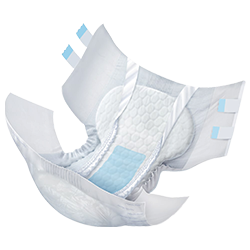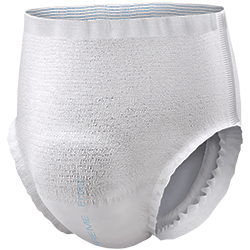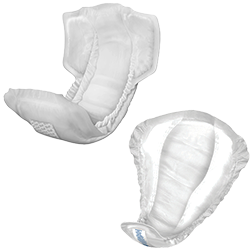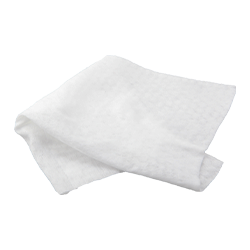Parkinson’s Disease: How to Manage Incontinence, Bladder, and Bowel Problems

Parkinson’s disease (PD) is a progressive disorder that affects the central nervous system, and with it, all parts of the body that are controlled by nerves. Like many neurological diseases, symptoms may look slightly different for each patient, but there are a number of symptoms that remain mostly universal. Involuntary movement such as tremors, muscle stiffness, slowed movement, and impaired balance are the four hallmark symptoms of PD.
With nearly 90,000 patients in the U.S. diagnosed with PD every year, it’s considered the second most common neurodegenerative disorder in the country.[1] And still, the journey to a proper diagnosis is difficult. Without a single specific lab or imaging test that can diagnose Parkinson’s disease, patients must undergo several varying types of exams before a doctor can provide a confident diagnosis.
How Parkinson’s Disease Affects the Bladder
While patient experiences vary in intensity and scope as their disease progresses, some of the most frequently reported non-motor Parkinson’s disease symptoms are those that affect a patient’s bladder and urination. Recent studies have shown that up to 40% of people with Parkinson’s have some degree of urinary problems.[2]
Most commonly, patients experience an overly frequent and urgent need to urinate – especially at night. Symptomatic of an irritated or overactive bladder, issues arise when a patient’s bladder signals to the brain that it is full when it is not.
Additionally, as the disease progresses and the patient loses more control of their involuntary reflexes, urinary incontinence also becomes more common, affecting up to 15% of PD patients. [3]
How Parkinson’s Disease Affects the Bowel
The most common gastrointestinal challenge associated with Parkinson’s disease is constipation. Affecting up to two-thirds of Parkinson’s patients, it’s a challenging symptom with many causes.[4] Combined with the side effects of many PD-specific medications and the difficulty that many experience in getting enough fluids and fiber in their diets, Parkinson’s disease effectively slows down a person’s entire digestive and gastric motility function.
For many individuals, increased constipation is one of the first symptoms they experience, often well before motor symptoms begin or any sort of official diagnosis.
Additionally, once constipation becomes regular and severe enough, bowel obstruction becomes a concern. A dangerous condition in which part of the gut is blocked, leading to potential fecal leakage, bowel obstruction is considered a medical emergency and could require surgery to resolve.
Furthermore, Parkinson’s disease-related bowel incontinence can also be a result of nerve dysfunction of the anal sphincter, the ring of muscle that controls when feces is released, in addition to increased cognitive and mobility impairment that can interfere with a patient’s ability to get to the toilet in time.
Treatment Options for Bladder & Bowel Dysfunction
Whether you or a loved one have been recently diagnosed with Parkinson’s disease, or if you’ve been coping with this diagnosis for some time, it’s important to remember that an improved quality of life is still possible! Especially when it comes to general urinary and bowel challenges, there are small but impactful tweaks anyone can employ to make the day-to-day a little easier.
-
Increase fluid and fiber intake. While many individuals instinctively restrict their fluids to avoid frequent trips to the bathroom, this can make both urinary incontinence and constipation challenges much worse. Aim for at least eight 8-oz glasses of water a day while avoiding common diuretics such as caffeine and alcohol as much as possible. Moreover, work on incorporating more fruits, beans, vegetables, seeds, nuts, and whole grains into your diet. In addition to being good sources of fiber, these foods help create bulk, which further aids digestion.
-
Talk to your doctor about adding an over-the-counter stool softener or laxative. MiraLAX and Colace are two popular options that work in slightly different ways. MiraLAX is an osmotic laxative that works by attracting water to the colon, while Colace is an emollient laxative that works by softening stool.
-
A urologist can advise about the best prescription options for your unique bladder symptoms. There is a wealth of medications available for those suffering from PD-related incontinence, and new research is conducted every year to find even better treatments. A healthcare provider such as a urologist can help figure out the best medications for individual situations.
-
Incorporate pelvic floor exercises into your daily routine. A helpful solution for both men and women, pelvic floor exercises such as Kegels work to strengthen the muscles that control urinary and bowel movement. It’s a simple workout that can be done anywhere. Learn more from helpful how-to guides online, or ask a healthcare provider for more information.
Incontinence Support & Management
If you or your loved one are struggling more with incontinence – whether frequent or infrequent, bladder or bowel – the quickest way to improve your quality of life is to find the right kind of absorbent product that works best for you.
Pull-on disposable underwear offers a great absorbency option for anyone experiencing incontinence from Parkinson’s disease. Perfect for those who are still toileting, a pull-on like NorthShore’s GoSupreme style helps to keep its wearer dry in the event of any unintentional leakage or accidents. Even suitable for those experiencing heavy incontinence, GoSupreme’s maximum absorbency promises up to eight hours of leak-free protection.
Additionally, for those who need less frequent or lighter protection, DynaDry Supreme Liners are highly absorbent liners designed to be worn in regular underwear. Great for men or women, DynaDry liners are contoured to fit closer to the body with leak guards that guarantee better leak protection and containment.
Take Care
While Parkinson’s disease remains an immensely challenging diagnosis to receive, the incontinence symptoms that come with it should not be allowed to make it any more difficult. Know that no matter what else you’re going through, there are still ways that you can continue living a life you love.
At the end of the day, the choice to wear absorbency products has the potential to be an immediate game-changer for anyone living with Parkinson’s disease. Everyone deserves to live without fear of leaks or accidents, and those with PD are no different.
If you need any help along the way in deciding which kind of absorbency product is right for you, don’t hesitate to contact us. Additionally, our product sample program allows you to try out any of our premium products before purchasing so that you can learn for yourself what feels best.
[1] https://www.parkinson.org/understanding-parkinsons/statistics
[2] https://www.parkinson.org/library/fact-sheets/urinary-problems
[3] https://www.parkinson.org/library/fact-sheets/urinary-problems
[4] https://www.medicalnewstoday.com/articles/parkinsons-and-constipation
Shop Incontinence Products
Starting at $13.99
FSA/HSA Eligible
Starting at $8.99
FSA/HSA Eligible
Starting at $3.99
FSA/HSA Eligible
Starting at $7.50
FSA/HSA Eligible
Starting at $4.99
FSA/HSA Eligible
Starting at $2.49
FSA/HSA Eligible












